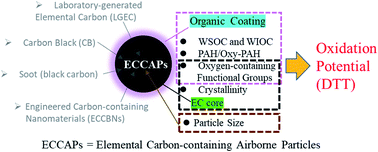The oxidative potential of fresh and aged elemental carbon-containing airborne particles: a review†
Abstract
Elemental carbon is often found in ambient particulate matter (PM), and it contributes to the PM's oxidative potential (OP) and thus poses great health concerns. Previous review articles mainly focused on the methodologies in evaluating OP in PM and its relationship with selected chemical constituents, including metal ions, PAHs, and inorganic species. In recent years, growing attention has been paid to the effect of atmospheric aging processes on the OP of EC-containing airborne particles (ECCAPs). This review investigates more than 150 studies concerning the OP measurements and physico-chemical properties of both fresh and aged ECCAPs such as laboratory-generated elemental carbon (LGEC), carbon black (CB), soot (black carbon), and engineered carbon-containing nanomaterials (ECCBNs). Specifically, we summarize the characteristics of water-soluble and insoluble organic species, PAHs, quinone, and oxygen-containing functional groups (OFGs), and EC crystallinity. Both water-soluble organic carbon (WSOC) and water-insoluble organic carbon (WIOC) contribute to the OP. Low molecular weight (MW) PAHs show a higher correlation with OP than high MW PAHs. Furthermore, oxidative aging processes introduce OFGs, where quinone (C![[double bond, length as m-dash]](https://www.rsc.org/images/entities/char_e001.gif) O) and epoxide (O–C–O) increase the OP of ECCAPs. In contrast, carboxyl (–COOH) and hydroxyl (–OH) slightly change the OP. The low crystallinity of EC favors the oxygen addition and forms active OFG quinone, thus increasing the OP. More detailed analyses for the EC microstructures and the organic coatings are needed to predict the OP of ECCAPs.
O) and epoxide (O–C–O) increase the OP of ECCAPs. In contrast, carboxyl (–COOH) and hydroxyl (–OH) slightly change the OP. The low crystallinity of EC favors the oxygen addition and forms active OFG quinone, thus increasing the OP. More detailed analyses for the EC microstructures and the organic coatings are needed to predict the OP of ECCAPs.

- This article is part of the themed collection: Atmospheric chemistry


 Please wait while we load your content...
Please wait while we load your content...